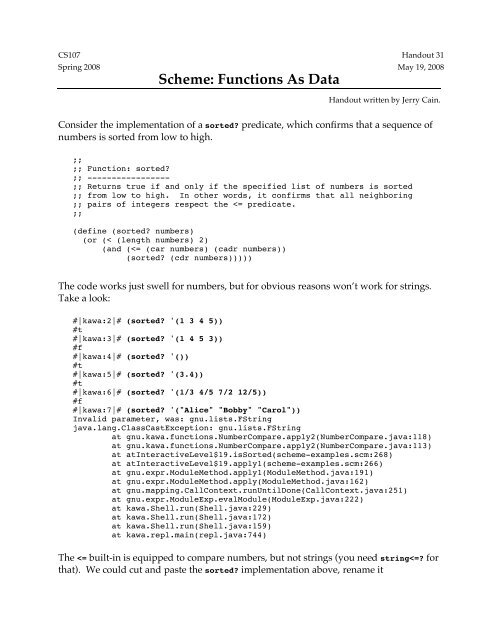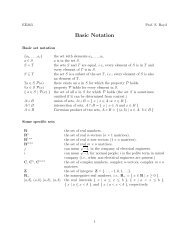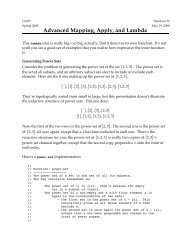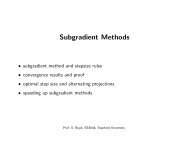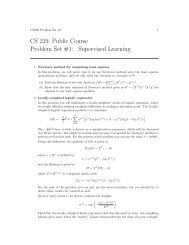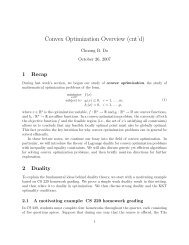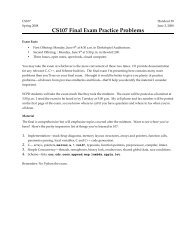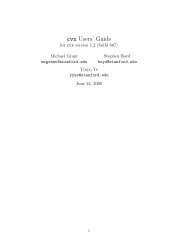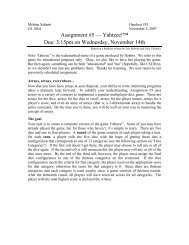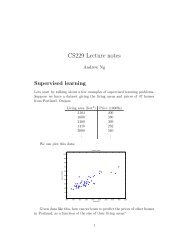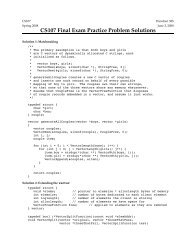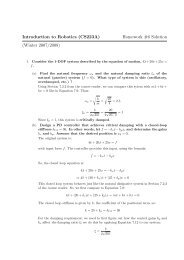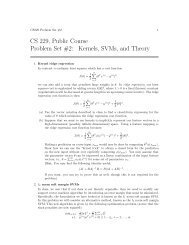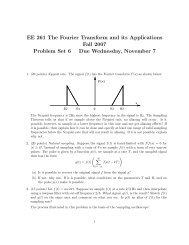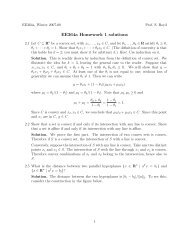Scheme: Functions As Data
Scheme: Functions As Data
Scheme: Functions As Data
Create successful ePaper yourself
Turn your PDF publications into a flip-book with our unique Google optimized e-Paper software.
CS107 Handout 31<br />
Spring 2008 May 19, 2008<br />
<strong>Scheme</strong>: <strong>Functions</strong> <strong>As</strong> <strong>Data</strong><br />
Handout written by Jerry Cain.<br />
Consider the implementation of a sorted? predicate, which confirms that a sequence of<br />
numbers is sorted from low to high.<br />
;;<br />
;; Function: sorted?<br />
;; -----------------<br />
;; Returns true if and only if the specified list of numbers is sorted<br />
;; from low to high. In other words, it confirms that all neighboring<br />
;; pairs of integers respect the
string-sequence-sorted?, and change the
those symbols. The code is caught by a local variable called comp, and because comp sits<br />
at the front of the sub-expression:<br />
(comp (car sequence) (cadr sequence)),<br />
it’s the symbol that evaluates to the code that tells the interpreter what to do with the<br />
remaining arguments.<br />
Implementing mergesort<br />
We could have framed our implementation of partition and quicksort to be generic by<br />
passing in a binary comparator function in addition to the sequence to be sorted. Rather<br />
than going back and revisiting an old example, we’ll back a new sort routine by a<br />
different algorithm: mergesort.<br />
Mergesort relies on a helper function—let’s call it merge—that takes two sorted lists and<br />
synthesizes a new, sorted list by merging the original two. Mergesort is a common<br />
enough sorting algorithm that you probably saw it in CS106B or CS106X. If not, don’t<br />
fret, because it’s conceptually trivial.<br />
If we have two rational number lists sorted from high to low, we can merge them this<br />
way:<br />
#|kawa:2|# (merge '(1/3 1/5 1/7 1/9) '(1/2 1/4 1/6 1/8 1/10 1/11) >)<br />
(1/2 1/3 1/4 1/5 1/6 1/7 1/8 1/9 1/10 1/11)<br />
If text is your thing and you’re merging string lists, you call merge within a string<br />
comparator instead:<br />
#|kawa:3|# (merge '("c" "c++" "java" "python" "tcl") '("ruby" "scheme") string
;;<br />
;; Function: merge<br />
;; ---------------<br />
;; Takes the two lists, each of which is assumed to be sorted<br />
;; according to the specified comparator function, and synthesizes<br />
;; an fresh list which is the sorted merge of the incoming two.<br />
;;<br />
;; If one of the lists is empty, then merge can just return the<br />
;; other one. If not, then the specified comp is used to determine<br />
;; which of the two cars deserves to be at the front. Recursion (what else?)<br />
;; is then used to generate the merge of everything else, and the winning<br />
;; car is consed to the front of it.<br />
;;<br />
(define (merge list1 list2 comp)<br />
(cond ((null? list1) list2)<br />
((null? list2) list1)<br />
((comp (car list1) (car list2))<br />
(cons (car list1)<br />
(merge (cdr list1) list2 comp)))<br />
(else<br />
(cons (car list2)<br />
(merge list1 (cdr list2) comp)))))<br />
The function comment explains the two base cases and the two recursive calls.<br />
The mergesort routine is much easier once merge has been written and tested. The<br />
hardest thing about mergesort is figuring out how to separate the list into two lists of<br />
roughly equal length so that each can be recursively mergesorted and then merged<br />
together. We need a function that returns a copy of the first k elements of an n-element<br />
list. Some implementations of <strong>Scheme</strong> provide built-in functions like nth-cdr and (the<br />
tragically named) butlast to help return the front and back portions of a list. Our<br />
version doesn’t, so we need to write our own quick and dirty versions. (Actually, we get<br />
away with just the second of them: I call is prefix-of-list).<br />
;;<br />
;; Function: prefix-of-list<br />
;; ------------------------<br />
;; Accepts a list and returns a new list with just the<br />
;; first k elements. If k is greater than the original<br />
;; list length, the entire list is replicated. If k is<br />
;; negative, then don't except it to work. :)<br />
;;<br />
(define (prefix-of-list ls k)<br />
(if (or (zero? k) (null? ls)) '()<br />
(cons (car ls) (prefix-of-list (cdr ls) (- k 1)))))<br />
4
;;<br />
;; Function: mergesort<br />
;; -------------------<br />
;; Sorts the incoming list called ls so that all neighboring<br />
;; pairs of the final list respect the specified comparator function.<br />
;;<br />
;; mergesort works by taking the unsorted list, generating copies of<br />
;; the front half and the back half, recursively sorting them, and then<br />
;; merging the two. Classic mergesort.<br />
;;<br />
;; The reverse call is a bit hokey, but it brings the back half to<br />
;; the front so that our prefix-of-list function has access to the<br />
;; back-end elements. The fact that the elements are in the reverse<br />
;; of the original order is immaterial, since we don't care about<br />
;; the original order—just the order after it's been sorted.<br />
;;<br />
(define (mergesort ls comp)<br />
(if (? to sort numbers and strings:<br />
#|kawa:2|# (mergesort '(1 5 3 2 5 6 3 4 5 9 2) ?)<br />
(z y x w e d c b a)<br />
And as it should, it works even if we pass in a user-defined comparator, like<br />
distance-from-origin
6<br />
;;<br />
;; Function: distance-from-origin<br />
;; ------------------------------<br />
;; Returns the Euclidean distance of the specified<br />
;; two-dimensional point (expressed as a list of<br />
;; two numbers) from the origin. Thank you, Pythagorean Theorem.<br />
;;<br />
(define (distance-from-origin pt)<br />
(sqrt (+ (* (car pt) (car pt))<br />
(* (cadr pt) (cadr pt)))))<br />
;;<br />
;; Function: distance-from-origin
All of the examples above use map to map a unary function over all of the elements in a<br />
single list. Turns out you can map binary functions over two lists, as with:<br />
#|kawa:2|# (map append '((a b c) (x y z)) '((d e) (p d q)))<br />
((a b c d e) (x y z p d q))<br />
#|kawa:3|# (map + '(10 200 3000) '(7 8 9))<br />
(17 208 3009)<br />
#|kawa:4|# (map cons '("Haley" "Sarah" "Bond [arrogant pause]")<br />
#|(---:5|# '(("Joel" "Osment") ("Jessica" "Parker") ("James" "Bond")))<br />
((Haley Joel Osment) (Sarah Jessica Parker) (Bond [arrogant pause] James Bond))<br />
#|kawa:6|#<br />
The two lists should be of equal length. The first element of the result is what it is<br />
because the cars of the two lists were fed, in order, to the binary mapping function. The<br />
second element of the result was produced because the cadrs of the two lists were paired<br />
up, and so forth. Technically, the two lists don’t need to be of the same length, because<br />
map will just discard the extras of the longer one. We’re going to pretend that’s not the<br />
case and require that the two lists are of the same length.<br />
map can take up to n lists of equal length, provided the mapping function can take n<br />
arguments.<br />
#|kawa:15|# (map list '(1 2 3) '(10 20 30) '(100 200 300) '(1000 2000 3000))<br />
((1 10 100 1000) (2 20 200 2000) (3 30 300 3000))<br />
We’re already in a position to implement the unary version of map, so let’s do that. We’ll<br />
call our function unary-map to emphasize that the mapping function can only take one<br />
argument. (We’ll eventually be able to write the full version to take an arbitrary number<br />
of lists.)<br />
;;<br />
;; Function: unary-map<br />
;; -------------------<br />
;; We pretend that the map function doesn't exist, and we write<br />
;; our own. <strong>As</strong> you can see, it isn't all that difficult to get<br />
;; a unary version of map working.<br />
;;<br />
(define (unary-map fn seq)<br />
(if (null? seq) '()<br />
(cons (fn (car seq)) (unary-map fn (cdr seq)))))<br />
#|kawa:2|# (unary-map list '(a "b" 4.5 (#f #t #t)))<br />
((a) (b) (4.5) ((#f #t #t)))<br />
#|kawa:3|# (unary-map / '(5 6 99 121))<br />
(1/5 1/6 1/99 1/121)<br />
Provided the local variable fn is bound to code that takes a single argument,<br />
(fn (car seq)) generates a new element to replace the original. (Of course, the original<br />
7
list isn’t actually changed. It just determines the length and contents of the one being<br />
generated.)<br />
Apply<br />
The <strong>Scheme</strong> language provides another built-in called apply, which takes an n-ary<br />
function and a list of n expressions, effectively conses the function onto the front of the<br />
argument list, and then evaluates it. Here’s a trivial example:<br />
8<br />
#|kawa:2|# (apply + '(1 2 3 4))<br />
10<br />
#|kawa:3|# (sqrt (apply + (map * '(3 4) '(3 4))))<br />
5.0<br />
See what I mean when apply kinda, sorta conses the + onto the front of '(1 2 3 4) to get<br />
(+ 1 2 3 4), and then evaluates it as if the user actually typed (+ 1 2 3 4). The sqrt<br />
example is yet another way to illustrate that a 3-4-5 triangle has a 90 degree angle in<br />
there somewhere.<br />
Now, would you type in (apply + '(1 2 3 4)) to add the first four integers? Yes, but<br />
only if you’re showing off and/or the type of person who regularly recites π out to 430<br />
decimal places for fun. But in some situations, apply is really the best function to use.<br />
Here’s a small but meaningful example:<br />
;;<br />
;; Function: average<br />
;; -----------------<br />
;; Quick, clean way to compute the average of a set of numbers without<br />
;; using any exposed car-cdr recursion. This is the canonical example<br />
;; illustrating why apply belongs in a functional language.<br />
;;<br />
(define (average num-list)<br />
(/ (apply + num-list) (length num-list)))<br />
#|kawa:2|# (average '(3 5 9 11 3))<br />
31/5<br />
#|kawa:3|# (average '(99998 99999 100000 100001 100002))<br />
100000<br />
#|kawa:4|# (average '(3.4 8.3 2.7 6.6))<br />
5.25<br />
Without apply, we’d have to write a function to crawl down the list of numbers to<br />
produce a sum, all in spite of the fact that + already does something very, very similar.<br />
Here’s a real example: Let’s compute the depth of a list, where the depth of the list is<br />
equal to the largest number of open left parentheses. The problem statement views a list<br />
as an ordered tree, where nested lists are viewed as sub-trees. Where there’s a tree,<br />
there’s a clear metaphor for depth. Let’s listen in to see what depth has to say:
#|kawa:2|# (depth '("this" "list" "is" "shallow"))<br />
1<br />
#|kawa:3|# (depth '(this (list (has (substance)))))<br />
4<br />
#|kawa:4|# (depth '(1 (2 3 (4)) (((6) 7 ((((8 9)) 10) (11)))) '(4)))<br />
7<br />
#|kawa:5|# (depth '())<br />
0<br />
#|kawa:6|# (depth 4)<br />
0<br />
We could write this using cdr-cdr recursion, but there’s a lovely implementation using<br />
map and apply. Let’s say it in English first.<br />
The depth of a tree is zero if it’s the empty tree, or if it’s a primitive. This explains the<br />
last two of the five sample outputs above. Otherwise, the depth of a tree is one more<br />
than the deepest of any nested sub-tree. We can compute the depth of all of the top-level<br />
elements (some of which are primitives, some of which are lists), take the largest one,<br />
and add one to it. There’s a built-in function called max which takes one or more<br />
numbers as arguments and returns the largest one. We use it below:<br />
;;<br />
;; Function: depth<br />
;; ---------------<br />
;; Computes the depth of a list, where depth is understood<br />
;; to be the largest number of open left parentheses to the left<br />
;; of some primitive. We assume that () doesn't appear anywhere<br />
;; in the overall list.<br />
;;<br />
(define (depth tree)<br />
(if (or (not (list? tree)) (null? tree)) 0<br />
(+ 1 (apply max (map depth tree)))))<br />
We’re mapping a recursive function over the tree so that it’s applied to every single subtree.<br />
Recursion doesn’t get any more beautiful than this.<br />
We can also rewrite our flatten function by recursively flattening all of the sub-lists,<br />
and then levying append to thread all of those flattened sub-lists together. This example<br />
isn’t quite as elegant, because the recursive calls need to wrap primitives up as<br />
singletons so the append works. But it’s still another good example demonstrating how<br />
nicely apply and map play together:<br />
9
;;<br />
;; Function: flatten-list<br />
;; ----------------------<br />
;; Flattens a list just like the original flatten does, but<br />
;; it uses map, apply, and append instead of exposed car-cdr recursion.<br />
;;<br />
(define (flatten-list ls)<br />
(cond ((null? ls) '())<br />
((not (list? ls)) (list ls))<br />
(else (apply append (map flatten-list ls)))))<br />
#|kawa:2|# (flatten-list '(1 2 (3) 4))<br />
(1 2 3 4)<br />
#|kawa:3|# (flatten '(this (list (also has) substance) ((((([deep])))))))<br />
(this list also has substance [deep])<br />
10<br />
Inner Function Definitions and Lambdas<br />
Now we’re going to work on a function that takes a list of numbers and generates a new<br />
list where all of the original numbers have been shifted by some offset. We’ll call the<br />
function translate, and expect it to work as follows:<br />
#|kawa:2|# (translate '(7 4 2 -4 8 1) 50)<br />
(57 54 52 46 58 51)<br />
#|kawa:3|# (translate '(1 2 3 4 5 6) 1/8)<br />
(9/8 17/8 25/8 33/8 41/8 49/8)<br />
It’s simple enough to understand, but how do we implement it?<br />
We could use car-cdr recursion, but the specification just screams map, because a list of<br />
length n is generated from another list of length n. The problem is that the mapping<br />
function required access to the delta amount—the 50, or the 1/8.<br />
In C, we’d use the client data void * of VectorMap. In C++, we’d use a function object<br />
and embed client data inside. In <strong>Scheme</strong>, we have two options. Here’s the first:<br />
;;<br />
;; Function: translate<br />
;; -------------------<br />
;; Takes the specified list and the specified delta and generates<br />
;; a new list where every element of the original is shifted by the<br />
;; specified delta.<br />
;;<br />
(define (translate numbers delta)<br />
(define (shift number)<br />
(+ number delta))<br />
(map shift numbers))<br />
Note that the definition of translate defines an inner function called shift. That’s<br />
something that doesn’t really exist in any other language we’ve studied this quarter. But
<strong>Scheme</strong> (and a few modern languages—Python and Javascript come to mind) allow you<br />
to define a function within another function, on the fly. The magic is that the<br />
implementation of an inner function has access to the set of local parameters. That<br />
means the above implementation of shift has legitimate access not only to globally<br />
defined symbols like +, but also locally scoped ones like delta. The inner function<br />
definition only lasts as long as the outer function call, so the implementation of shift<br />
disappears as soon translate produces an answer.<br />
There’s one little functional paradigm violation here: translate is defined as a sequence<br />
of two expressions instead of just one. It’s legal <strong>Scheme</strong>: the implementation of a<br />
function can be a sequence of one or more expressions, where the result of the last<br />
expression is taken to be the result of the entire sequence. All of the other expressions<br />
prior to the last one are executed in sequence, and the runtime only senses their side<br />
effects (like the introduction of a new function definition). We said up front that<br />
functional paradigm purists frown on side effects. But this is different, because the side<br />
effect that comes with an inner function definition is far from permanent. It lives only as<br />
long as it’s needed by the outer function.<br />
The second, more famous option is the anonymous function. If we’re to use map, then<br />
translate has to map something over the list of numbers. That something can be defined<br />
in place as a nameless function where only the argument list and the body of the<br />
function get typed out:<br />
;;<br />
;; Function: translate<br />
;; -------------------<br />
;; Takes the specified list and the specified delta and generates<br />
;; a new list where every element of the original is shifted by the<br />
;; specified delta. This version uses the lambda construct<br />
;; to define a nameless function in place.<br />
;;<br />
(define (translate numbers delta)<br />
(map (lambda (number) (+ number delta)) numbers))<br />
Look at that. We’re calling map, and we’re apparently mapping over something called<br />
numbers. Everything else, because it’s parenthesized, is occupying the space that’d<br />
normally be occupied by something that evaluates to a function.<br />
Well, that (lambda (number) (+ number delta)) expression is a function. It’s the quick<br />
and dirty way of defining a function, on the fly, without even giving it a name.<br />
Everything after the lambda symbol would be included verbatim in an inner function<br />
definition (in fact, it was included verbatim with the inner definition of shift). lambda is<br />
a gesture to programming language theory and the mathematics that backs it: lambda<br />
calculus. We invent the function definition the moment we need it. It has access to the<br />
11
locally defined symbol called delta. It goes away as soon as translate is finished. No<br />
messy side effects.<br />
12


